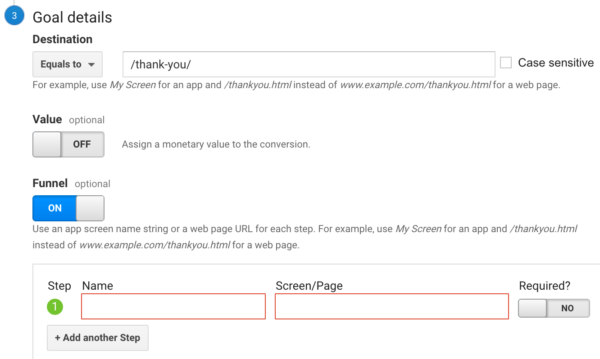Discover the Limitations of Google Analytics Goals: Introducing the Data Types That Remain Untrackable
As businesses progressively count on data-driven decision-making, understanding the limitations of tools like Google Analytics ends up being vital. While Google Analytics Goals offer important understandings right into user interactions, there exist data types that avoid tracking, posturing obstacles to a detailed understanding of individual habits. These untrackable data kinds elevate concerns regarding the precision and efficiency of the analytics data that companies greatly count upon for their digital techniques. Curious to discover the concealed blind places in your data evaluation procedure?
Incomplete Customer Trip Tracking
Insufficient customer trip monitoring within Google Analytics can hinder the capability to properly assess individual habits. When the user journey is not completely tracked, there are voids in the data that protect against a comprehensive understanding of how customers connect with a website. This lack of understanding can cause missed opportunities for optimization and improvements to the individual experience.
One typical problem with incomplete user journey monitoring is the inability to see the complete path that individuals take in the past finishing a goal or leaving the website. Without this info, it is testing to identify where individuals may be experiencing challenges or friction points that stop them from converting. In addition, incomplete tracking can cover the effect of specific advertising and marketing initiatives or site changes on individual actions.
To resolve this restriction, it is essential to establish proper tracking devices within Google Analytics to capture the whole user trip. This may involve setting up event monitoring, goal funnels, or utilizing devices like Google Tag Supervisor to make sure that no essential communications go unrecorded. By acquiring a detailed sight of the user trip, website owners can make even more informed choices to enhance customer interaction and drive conversions.
Attribution Challenges
Browsing through acknowledgment obstacles in Google Analytics requires a complete understanding of exactly how various touchpoints add to the total conversion procedure. Acknowledgment challenges occur from the complexity of modern client journeys, where users engage with numerous networks prior to converting. Google Analytics provides numerous attribution designs like initial touch, last touch, and linear, each offering a various point of view on exactly how credit is appointed to touchpoints along the conversion course. Nonetheless, these designs may not constantly precisely mirror real effect of each touchpoint on the conversion.
One typical attribution difficulty is the problem in connecting conversions to the right resource, especially in cases where users communicate with numerous networks prior to transforming. Additionally, cross-device monitoring poses one more attribution challenge, as users commonly change in between gadgets throughout their journey, making it challenging to track their interactions flawlessly.
Offline Conversions
Given the difficulties associated with connecting conversions properly in online channels, the dimension of offline conversions offers a significant opportunity for marketers looking for an extra thorough understanding of their consumers' trip. Offline conversions refer to actions that clients absorb the physical globe, such as making purchases in brick-and-mortar stores or over the phone, going to events, or involving with printed products - what data is google analytics goals unable to track. These conversions are essential for companies that run both online and offline, as they give important understandings into the efficiency of marketing projects throughout different touchpoints
Tracking offline conversions commonly presented a considerable challenge for marketing experts, as it was testing to connect these actions back to details on the internet interactions accurately. With innovations in modern technology, such as the assimilation of CRM systems, distinct identifiers, and voucher codes, services can currently link the space in between online and offline data to obtain an extra holistic sight of customer behavior. By properly determining offline conversions, marketing experts can enhance their strategies, allocate resources extra successfully, and ultimately boost the general client experience.
Cross-Device Tracking
Cross-device tracking plays a vital role in recognizing the interconnected nature of customers' digital communications throughout multiple gadgets. In today's omnichannel world, where users effortlessly change between mobile phones, tablet computers, and desktops, tracking their behavior across these tools is essential for online marketers to acquire a detailed view of their customer trip.

Moreover, personal privacy concerns and policies such as GDPR and CCPA have additionally difficult cross-device monitoring. With users requiring even more control over their data and enhanced constraints on tracking innovations, online marketers need to locate innovative and privacy-compliant ways to connect customer interactions throughout gadgets.
Dynamic Web Content Interaction
Understanding user involvement with vibrant web content is essential in maximizing electronic advertising and marketing approaches for enhanced audience communication. Dynamic content describes web site elements that change based upon individual behavior, preferences, or various other elements, supplying a tailored experience. Tracking user interactions with vibrant content poses challenges for typical analytics devices like Google Analytics.
While Google Analytics can track fundamental communications like clicks and web page sights, it might struggle to catch more nuanced engagements within vibrant web content. what data is google analytics goals unable to track. Metrics such as time invested in particular vibrant components, hover actions, or interactions within pop-ups are commonly not quickly quantifiable making use of typical monitoring approaches. This restriction impedes marketers' capability to completely grasp just how individuals are engaging with dynamic material and tailor their strategies as necessary

Conclusion
Finally, Google Analytics objectives have limitations in tracking insufficient user journeys, attributing conversions properly, capturing offline conversions, tracking cross-device interactions, and gauging vibrant material involvement. These restraints highlight the importance of discovering extra tracking approaches and devices to acquire a much more detailed understanding of individual actions and conversions past what Google Analytics can give.
While Google Analytics Goals deal useful insights into customer communications, there exist data types that elude monitoring, posing obstacles to a detailed understanding of customer actions.Insufficient user trip monitoring within Google Analytics can prevent the capacity to accurately analyze customer actions. When the customer trip is not fully tracked, there are gaps in the information that stop a comprehensive understanding of how users engage with an click here now internet site.One usual problem with insufficient user trip tracking is the inability to see the full course that users take before finishing a goal or leaving the site. By getting an extensive sight of the individual trip, site owners can make more informed choices to boost customer involvement and drive conversions.